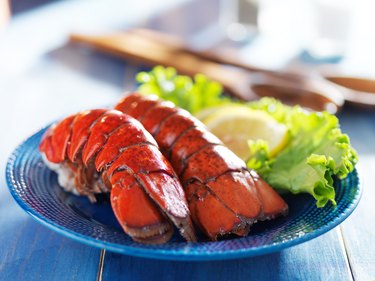
If you're ready to commit to cooking lobster, making lobster tails is a great place to start. Boiling lobster tails is one of the most common cooking methods, and it's beginner-friendly. A home-cooked lobster is a delicacy that you should enjoy if you're craving it.
Still, if you're new to cooking shellfish, you may not know the first thing about turning raw lobster into the steaming, bright red delicacy you're used to being served at restaurants. The good news? Preparing lobster tails is easier than you may think.
Video of the Day
Video of the Day
Boiling Lobster Tails Like a Pro
Celebrity chef Serena Poon shares the following things you'll need and steps to follow to boil 4-ounce lobster tails to perfection. Follow the chef's guide to lobster tails below for some culinary advice.
Things You'll Need
4-ounce lobster tails
Medium-to-large stockpot
Water
Himalayan sea salt
Damp cloth
Tongs
Sharp kitchen scissors
Butter
Garlic
Celery salt
Lemon zest
Fresh finely chopped herbs like thyme, dill or basil
1. Boil Water (but Don't Add the Lobster Tails)
Fill the stockpot with water. Add 1 tablespoon of Himalayan sea salt for every quart of water. Bring it to a boil.
2. Clean the Lobster Tail Shells With a Damp Cloth
Before adding the tails to the pot, make sure they're clean. Do this while you wait for the water to boil.
Use a damp cloth to gently wipe them down. Scrub the shell thoroughly to remove any debris. Do not scrub any exposed meat.
3. Devein the Lobster
A lobster tail needs to be deveined before you can eat it. It may be deveined at the time of purchase. So this step is optional if it's already been done, Poon says.
Deveining a lobster tail involves removing the thin, black intestine from the tail, according to the Utah Division of Wildlife Resources. To devein:
- Using a sharp knife, cut the tail open
- With a knife or pair of kitchen shears, cut into the tail's center lengthwise
- Remove the vein by hand
Typically, you don't cut the lobster tails before boiling them, so there's no need to get overzealous with your knife here.
4. Boil the Lobster Tails for 5 Minutes
Once the water has reached a boil, it's time to add the lobster tails. Like pasta, the cooking time only begins once you've added the lobster to boiling water. Use tongs to carefully place each of the lobster tails in the pot of boiling water.
Perhaps the most popular question that comes up is, how long to boil lobster tails? You'll want to boil 4-ounce tails for about 5 minutes, Poon says. Keep in mind that 5 minutes is recommended for raw 4-ounce lobster tails, while frozen lobster tails require more boiling time. You can also prepare frozen lobster that's been pre-cooked, which tends to require around seven minutes per pound of lobster.
You'll know when the lobster tails are done cooking by their appearance. The outer shell will be the bright red color you think of when you think of lobster. The inside meat will be an opaque white, according to FoodSafety.gov.
Tip
The most accurate way to check if lobster is done cooking is by measuring the internal temperature with a meat thermometer. To properly take the internal temperature of the lobster tails, insert a meat thermometer into the thickest part of the flesh where opaque, according to the Academy of Nutrition and Dietetics. It should read 140 degrees Fahrenheit, Poon says.
5. Remove the Lobster Tails
When the lobster tails are thoroughly cooked, carefully remove them with tongs. Put them aside and let them cool for a few minutes.
6. Season and Serve
Use a pair of sharp kitchen shears to cut the lobster tails down the middle. This exposes the edible meat in the tail. Poon recommends butterflied lobster tails, which is a way of cutting and serving the tails so the meat faces up.
The green pasty stuff that may sometimes linger on the tail is known as tomalley and is the lobster's liver and pancreas. The Maine Division of Environmental and Community Health recommends not eating any tomalley. Tests have shown that it can have contaminants found in the environment.
Tip
Lobster is often served with butter, and Poon recommends making melted garlic-herb butter. Mix together butter, garlic, celery salt, lemon zest and fresh, finely chopped herbs like thyme, basil or dill. Drizzle the butter sauce onto the tails and serve.
Is Lobster Healthy?
Lobster can be a healthy pick for a lean, protein-packed meal. It is low in fat and high in protein. According to the USDA, one lobster tail (85 grams) contains:
- Calories: 60
- Protein: 14 g
- Fat: 0
- Fiber: 0
- Sugars: 0
- Sodium: 350 mg
- Cholesterol: 69.7 mg
Lobster also contains a fair amount of good-for-you minerals, like zinc, calcium, phosphorus, selenium and potassium, per Consumer Reports. You may be wondering about the cholesterol in lobster; the tail alone contains 23% of the recommended daily value (DV). When it comes to managing your cholesterol levels, however, it's more important to focus on saturated fat in your diet — of which lobster tails have very little, per Consumer Reports.
Lobster is probably most unhealthy when it is doused in butter, which dramatically increases the amount of calories and fat you're ingesting. It's a good idea to limit the butter sauce to a drizzle or a dip, or concoct something just as delicious, like a vinaigrette or a homemade aioli.
- Utah Division of Wildlife Resources: “Crayfishing for fun and food”
- FoodSafety.gov: “Safe Minimum Cooking Temperatures Chart”
- Academy of Nutrition and Dietetics: "A Short Guide to Food Thermometers"
- USDA: "Lobster Tails"
- Maine Division of Environmental and Community Health: "Saltwater Fish & Lobster Tomalley Safe Eating Guidelines"
- Consumer Reports: "Is Lobster Good For You?"